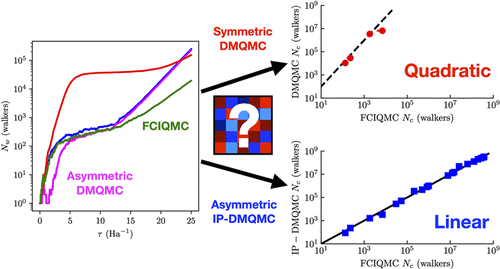当前位置:
X-MOL 学术
›
J. Chem. Theory Comput.
›
论文详情
Our official English website, www.x-mol.net, welcomes your
feedback! (Note: you will need to create a separate account there.)
The Sign Problem in Density Matrix Quantum Monte Carlo
Journal of Chemical Theory and Computation ( IF 5.7 ) Pub Date : 2021-09-21 , DOI: 10.1021/acs.jctc.1c00078 Hayley R Petras 1 , William Z Van Benschoten 1 , Sai Kumar Ramadugu 1 , James J Shepherd 1
Journal of Chemical Theory and Computation ( IF 5.7 ) Pub Date : 2021-09-21 , DOI: 10.1021/acs.jctc.1c00078 Hayley R Petras 1 , William Z Van Benschoten 1 , Sai Kumar Ramadugu 1 , James J Shepherd 1
Affiliation

|
Density matrix quantum Monte Carlo (DMQMC) is a recently developed method for stochastically sampling the N-particle thermal density matrix to obtain exact-on-average energies for model and ab initio systems. We report a systematic numerical study of the sign problem in DMQMC based on simulations of atomic and molecular systems. In DMQMC, the density matrix is written in an outer product basis of Slater determinants. In principle, this means that DMQMC needs to sample a space that scales in the system size, N, as O[(exp(N))2]. In practice, removing the sign problem requires a total walker population that exceeds a system-dependent critical walker population (Nc), imposing limitations on both storage and compute time. We establish that Nc for DMQMC is the square of Nc for FCIQMC. By contrast, the minimum Nc in the interaction picture modification of DMQMC (IP-DMQMC) is only linearly related to the Nc for FCIQMC. We find that this difference originates from the difference in propagation of IP-DMQMC versus canonical DMQMC: the former is asymmetric, whereas the latter is symmetric. When an asymmetric mode of propagation is used in DMQMC, there is a much greater stochastic error and is thus prohibitively expensive for DMQMC without the interaction picture adaptation. Finally, we find that the equivalence between IP-DMQMC and FCIQMC seems to extend to the initiator approximation, which is often required to study larger systems with large basis sets. This suggests that IP-DMQMC offers a way to ameliorate the cost of moving between a Slater determinant space and an outer product basis.
中文翻译:

密度矩阵量子蒙特卡罗中的符号问题
密度矩阵量子蒙特卡罗 (DMQMC) 是最近开发的一种方法,用于对N粒子热密度矩阵进行随机采样,以获得模型和从头算系统的精确平均能量。我们报告了基于原子和分子系统模拟的 DMQMC 符号问题的系统数值研究。在 DMQMC 中,密度矩阵写在 Slater 行列式的外积基中。原则上,这意味着 DMQMC 需要对系统大小N缩放的空间进行采样,如 O[(exp(N)) 2 ]。在实践中,消除符号问题需要总步行者人口超过系统相关的临界步行者人口(N c),对存储和计算时间施加限制。我们建立ñ Ç为DMQMC是的平方ñ Ç为FCIQMC。相比之下,DMQMC(IP-DMQMC)的交互图片修改中的最小N c仅与N c线性相关对于 FCIQMC。我们发现这种差异源于 IP-DMQMC 与规范 DMQMC 的传播差异:前者是非对称的,而后者是对称的。当在 DMQMC 中使用非对称传播模式时,随机误差要大得多,因此对于没有交互图片自适应的 DMQMC 来说成本高得令人望而却步。最后,我们发现 IP-DMQMC 和 FCIQMC 之间的等价性似乎扩展到发起者近似,这通常是研究具有大基组的大型系统所必需的。这表明 IP-DMQMC 提供了一种降低在 Slater 行列式空间和外积基础之间移动的成本的方法。
更新日期:2021-10-12
中文翻译:

密度矩阵量子蒙特卡罗中的符号问题
密度矩阵量子蒙特卡罗 (DMQMC) 是最近开发的一种方法,用于对N粒子热密度矩阵进行随机采样,以获得模型和从头算系统的精确平均能量。我们报告了基于原子和分子系统模拟的 DMQMC 符号问题的系统数值研究。在 DMQMC 中,密度矩阵写在 Slater 行列式的外积基中。原则上,这意味着 DMQMC 需要对系统大小N缩放的空间进行采样,如 O[(exp(N)) 2 ]。在实践中,消除符号问题需要总步行者人口超过系统相关的临界步行者人口(N c),对存储和计算时间施加限制。我们建立ñ Ç为DMQMC是的平方ñ Ç为FCIQMC。相比之下,DMQMC(IP-DMQMC)的交互图片修改中的最小N c仅与N c线性相关对于 FCIQMC。我们发现这种差异源于 IP-DMQMC 与规范 DMQMC 的传播差异:前者是非对称的,而后者是对称的。当在 DMQMC 中使用非对称传播模式时,随机误差要大得多,因此对于没有交互图片自适应的 DMQMC 来说成本高得令人望而却步。最后,我们发现 IP-DMQMC 和 FCIQMC 之间的等价性似乎扩展到发起者近似,这通常是研究具有大基组的大型系统所必需的。这表明 IP-DMQMC 提供了一种降低在 Slater 行列式空间和外积基础之间移动的成本的方法。










































 京公网安备 11010802027423号
京公网安备 11010802027423号